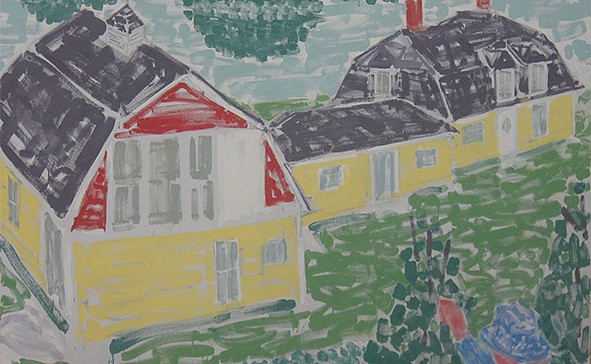
The Fairfield University Art Museum Announces Major Gift of Artwork by Artist Stephen Pace
February 13, 2021 - Fairfield University Art Museum
The Fairfield University Art Museum has received a major gift of more than 130 paintings, watercolors, drawings, prints, and sketchbooks from the Stephen and Palmina Pace Foundation.
The Fairfield University Art Museum is pleased to announce that the Stephen and Palmina Pace Foundation has gifted more than 132 works by Stephen Pace (American, 1918-2010) to the museum, with outstanding examples from across the artist’s oeuvre.
Stephen Pace was born in Missouri in 1918 to a farming family. He began his formal art training at the age of 17, studying drawing and watercolor with WPA artist and illustrator Robert Lahr. He continued to hone his skills while serving abroad during World War II, painting views of European landscapes. Pace’s early works are represented in this gift by a very early and accomplished watercolor of a farm scene from his childhood in Missouri. After WWII, Pace studied art on the GI Bill at the Instituto Allende in San Miguel Allende, Mexico before he made his way to New York City. This period is represented by a lovely oil painting of the Mexican desert landscape looking towards San Miguel Allende.
In 1947, Pace moved to New York City where he continued his art studies on the GI Bill at the Art Students League and developed important friendships with members of the New York School of Abstract Expressionist. Still lifes, nudes, and early abstractions are among the works included in the gift from this period. Pace used the last of his GI bill funds to study with the renowned abstract expressionist artist and teacher Hans Hofmann, in New York and then in Provincetown, Mass. Hofmann had an immediately visible influence on Pace’s work in the 1950s, particularly in Pace’s use of color planes to describe volume.
During the 1950s, Stephen was singled out by Hofmann as one of the finest painters to emerge from the second generation of abstract expressionists. During his long career, Pace made important contributions to the tradition of Abstract Expressionism. This period of abstract expressionism is represented by several important paintings, as well as numerous watercolors, prints, and drawings.
In 1960, Pace returned to painting more figural subjects in a style characterized by simplified forms and imaginative colors, and this remained the focus of his artistic practice for the remainder of his career. Returning to his rural roots, Pace’s work begins to depict subjects ranging from gardening and nudes, to horses and lobstermen. The gift to Fairfield includes all of these subjects, and is particularly strong in paintings of horses — one of Pace’s favorite subjects.
The donated works collectively are very important because they demonstrate Pace’s process in moving from studies to finished works. Pace's artwork will be well-used in teaching across disciplines, especially in Studio Art and Art History classes.
Three of the gifted works by Pace are among those in the current Fairfield University Art Museum (FUAM) exhibition in Bellarmine Hall Galleries, The Birds of the Northeast: Gulls to Great Auks: an ink drawing of a Great Blue Heron, and a watercolor and a lithograph of Herring Gulls. A full exhibition of Pace’s work is in the planning stages.
Back to News
